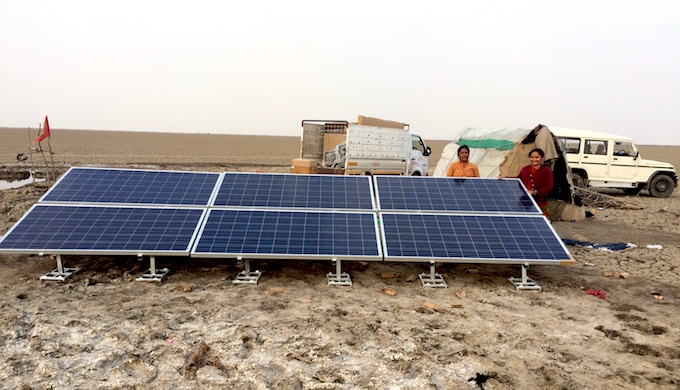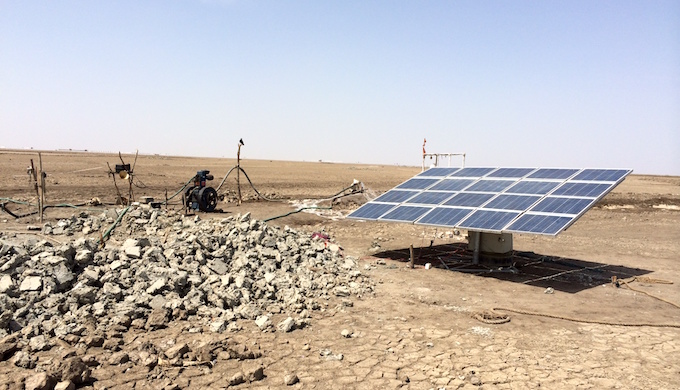Agariyas, the traditional salt farmers of the Little Rann of Kutch in Gujarat, are turning to the eco-friendly practice of using solar-powered pumps to lift brine and save substantially on diesel costs

Saltpan farmers are using solar-powered pumps to reduce production costs. (Photo by SEWA)
As you enter the Little Rann of Kutch in Gujarat, you can hear the sound of pumps drawing water. That is not new. What is new is that an increasing number of these pumps are now powered by sunlight rather than diesel to draw brine from wells. The brine is then spread on the broad salt pans. The water evaporates, the salt stays behind, and the farmers have used solar power twice, in different ways.
The business of salt production in this western corner of India is often owned and run by women and girls. Producing salt requires large volumes of water to be pumped into the pans, earlier with diesel-powered pumps. The fuel costs can eat up 70% of the profits of the Agariyas, a poor and marginalised community who have traditionally been the main salt producers in Gujarat.
The Grassroots Trading Network for Women (GTNfW), an initiative of the Self Employed Women’s Association (SEWA), has in the past few years introduced solar pumps to lower production costs. Far from grid-connected electricity, this clean energy option is providing a breakthrough for saltpan farmers, who produce nearly 70% of India’s salt. It is in line with the other work done by SEWA, an organisation of poor, self-employed women workers in the informal economy,
The Little Rann of Kutch is a desert for eight months of the year, but a wetland from June to September, when it is submerged by sea and rain water. This evaporates by October, when the salt season starts. Around 43,000 Agariyas produce salt from October to May, while they live in temporary shelters.
India’s abundant solar energy potential, with nearly 300 sunny days and high solar radiation, coupled with falling prices of solar photovoltaic panels, offer a powerful clean energy solution to power pumps in rural off-grid areas, including the desert and temporary villages where the Agariyas work and live. India is aggressively promoting clean and renewable energy initiatives and has set an ambitious target to install 100GW of energy capacity from solar power in the next few years.

The agariyas live in the desert for seven months in temporary shelters. (Photo by SEWA)
A salt farmer uses an average of 1,400 litres of diesel every season to produce about 700 tonnes of salt. After meeting the costs of production, the farmer earns a profit of only INR 15,000-20,000 (USD 225-300) for the whole season.
Eco-friendly savings
The solar-powered pumps help the salt pan workers save between INR 35,000-40,000 (USD 523-598) a year because they do not have buy diesel any more. They use the savings to repay the cost of the solar pumps in instalments over three to years.
In 2009, SEWA launched its Hariyali (Green Livelihood) initiative with an aim to deliver energy access, financial inclusion and gender empowerment for its members. Hariyali is implemented through the special purpose vehicle of GTNfW, a non-profit company registered under India’s company law. It is a producers’ company with members of SEWA holding over 95% stake. To empower women, solar pumps are bought by the women members of SEWA. Many Agariya women are members.
“Despite India being one of the top three salt producers in the world, the condition of salt workers in the Little Rann of Kutch has not really improved in all these years. One primary reason is the fluctuating and high cost of diesel, which eats into two-thirds of their profits. We thought if we could address this issue, it would improve their livelihood,” said Reema Nanavaty, Director, SEWA.
The initiative has side effects — better health and education opportunities. Many salt workers have been exploited by moneylenders who charge a high rate of interest for the purchase of diesel. Installing a solar pump allows them a measure of economic freedom.
Replacing dirty diesel
Currently, there are about 43,000 diesel-powered pumps in the Little Rann of Kutch. SEWA has so far replaced more than 232 with hybrid pumps that run on solar power during the day and on diesel for some four hours in the night. The initiative has been chosen as a finalist for this year’s prestigious Ashden International Awards, a globally recognised measure for excellence in the field of green energy.

Solar power replaces diesel during the day. (Photo by SEWA)
Each solar pump saves 2.7 tonnes of carbon dioxide emissions per year, Bhatnagar says. The biggest vendor for SEWA for the solar water pumps has been SunEdison Inc, which has supplied 200 so far. This year, SEWA, which counts more than 17,000 Agariyas as members, aims to install 500 additional pumps. The cost of each pump, including four solar panels, an inverter and the submersible pump itself, is around INR 150,000 (USD 2,246).
SEWA has piloted with 232 solar pumps over the past three years to demonstrate that a direct replacement of diesel by solar leads to saving of approximately 900 litres of diesel per season. It has also shown that a farmer is willing to use this saving to pay for the solar pumps in instalments.
“These (solar) pumps have more than halved the expenses on diesel and increased the salt production by approximately 15%, thus enabling the farmers to come out of poverty. In addition, during the off season, these solar panels are installed on the rooftops of the farmers’ homes, therefore saving on their electric bills,” said Anurag Bhatnagar, chief executive of GTNfW.
Due to the unstable nature of the salt trade in India, not too many commercial financiers have shown interest in getting involved in the initiative. However, SEWA has tied up with ICICI Bank, India’s largest private sector lender, to enable its salt worker members to buy and install up to 600 solar water pumps on instalment this year through GTNfW. SEWA targets to eventually replace all the 17,000 diesel pumps owned by its members to hybrid solar pumps.

Trackbacks/Pingbacks